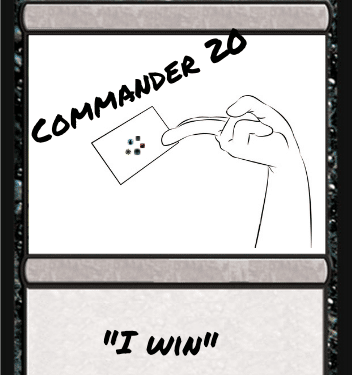How many lands in a commander deck? A question as old as 1996 and still relevant today.
The numbers have changed over the years of course. In the beginning, it was 40 lands, then 35, and now people say anywhere around 33-40.
Of course, here at commander20, we think that is too vague. As such, we came up with a formula to help players build efficient decks.
So, how many lands in a commander deck?
Simple, a commander deck should have 28+ your commander’s cost in lands.
So if you have a 4 mana commander, you should have 32 lands, or if you have a 10 mana commander, 38 lands.
The reasoning behind this is based off the central guide that goes over efficient deck building, The Rule of 20. A free guide that I give to everyone interested in becoming a better deck builder.
The general basis is that a deck on average should have 20 pieces of ramp to advance their board state. The reasoning is explained in detail in the guide, but when you have 20 pieces of ramp, your land count matters much less and you develop a board much quicker.
So by running the magical number of 28+ Commanders CMC, you will be able to answer the question of “How many lands in a commander deck?” every time.
And, now let’s prove it with math.
Table of Contents
The Math For How Many Lands In A Commander Deck?

To do this, we used deckstats probability calculator to show how your land count will look.
To do this I built an example using Lathril, blade of the elves as the commander. Her CMC is 4 so the deck should have 32 lands in it.
Now, if we assume you are running exactly 20 pieces of ramp with a mana cost between 1-3, then you will effectively have 52 lands as long as you can get to 2 lands.
Which the probability calculator shows an 85% chance of happening (pre-mulligans). Therefore, this should be relatively easy to achieve for most players. (Each additional land only gives you a 1% increased chance to have 2 or more lands by turn 2 btw)
Now, if that is the case, then if we ran 20 ramp cards that can generate our mana, then 85% of the time we will effectively have 52 mana sources in the deck. This means we have a 92% chance of being able to have 4 mana sources for our commander on turn 4.
Comparing Rule 20 land count to others

Now, what if we use the old rules of 36 lands and 10 sources of ramp that Command Zone Recommends?
Assuming the same commander and Mana Ramp CMC, you have a 90% chance to have 2 lands by turn. This is undoubtedly better than the 85% that 32 lands have. But, you only have an 84% chance to have 4 mana sources for your commander by turn 4.
If we were to compare this means you are less likely to be able to get your commander out by turn 4 running 36 lands and 10 ramp over 32 lands and 20 ramp. This of course ignores the fact that 20 forms of ramp can get your commander out sooner than 10 forms. Which has a drastic impact on the tempo of your board state. As shown in detail on my Guide To Efficient Deck Building.
But let’s go over some additional reasons why your lands for your commander deck should be 28+ your commander CMC.
Theory Behind how many lands in a commander deck
There is 1 main theory in which this number became relevant, Quadrant Theory.
The basic idea of Quadrant Theory is that there are four places you can be in the game: (1) Developing, (2) Ahead, (3) At Parity, and (4) Behind. Let’s take a few moments and evaluate When lands are useful in comparison to these situations.
- While developing, basic land allows you to keep parity. It allows you to play all your other cards, but it does not accelerate development of your board.
- While ahead, a basic land is a dead card. If you have a blightsteel collosus on the board, you’re very far ahead.
- At Parity, a basic land is a dead card. You play it but it does virtually nothing for actually progressing your board at this point and does not stop your opponents either.
- Behind, a basic land allows you to try and keep up with your opponent’s mana. But, If your opponent has a game-ending play, you’re far behind, then your lands do nothing to help.
This means in general, basic land is only good for keeping parity with your opponents in the early stages. It does nothing for actually developing your board after you reach your ramps CMC, it does nothing while ahead, at parity, or behind.
But there is something that does the job of land while also allowing you to accelerate your board, ramp. Ramp is much better than land because you can play more than 1 a turn. With this one restriction removed, even if the ramp cost a little bit, it becomes much better than a land.
So as such your land count should only be considered for developing your board state, after that, a land is usually one of the last things you want to draw as it does nothing for you. Especially when you already have one in hand. So by relying on your lands only to cast your commander (the strategy on which most decks are based) you will find that every other card type becomes much more impactful. Meaning to answer the question on “how many lands in a commander deck?” should be as stated 28 + Commander CMC.
Conclusion
I hope this answer was insightful for you! I think this will put the question of “How many lands in a commander deck” to rest. This provides a flexible route that caters to any commander you want to play. Of course, going 1-2 more or less is still good but this should give you a baseline that all your decks should have. If you are interested in developing an even better understanding to effecient deck building I highly recommend giving my guide of Rule 20 a read. It’s an insightful guide that I spent hours working on to answer any and all basic questions to building efficient decks.
P.S.Have fun playing and remember, lands aren’t free real estate when you can only play 1 a turn!


One reply on “How Many Lands In A Commander Deck”
[…] reason is explained in this article, but the general reason is that lands are best for casting your commander and ramping, outside of […]